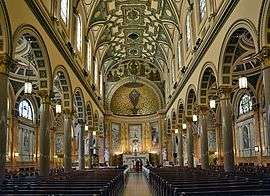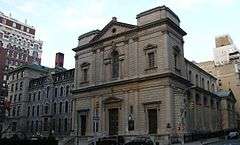Church of St. Ignatius Loyola (New York City)
|
Church of St. Ignatius Loyola | |
|
St. Ignatius Loyola complex, March 2009 | |
   | |
| Location | 980 Park Avenue, New York City, New York |
|---|---|
| Coordinates | 40°46′44″N 73°57′31″W / 40.77889°N 73.95861°WCoordinates: 40°46′44″N 73°57′31″W / 40.77889°N 73.95861°W |
| Area | 3.5 acres (1.4 ha) |
| Built | 1895-1900[1][2] |
| Architect | Schickel & Ditmars[1] |
| Architectural style | German Baroque; Classical Revival |
| Website | Church of St. Ignatius of Loyola (Manhattan) |
| NRHP Reference # | 80002679[3] |
| Added to NRHP | July 24, 1980 |
The Church of St. Ignatius of Loyola is a Roman Catholic parish church located on the Upper East Side of Manhattan, New York City, administered by the Society of Jesus (Jesuits). The parish is under the authority of the Archdiocese of New York, and was established in 1851 as St. Lawrence O'Toole's Church. In 1898, permission to change the patron saint of the parish from St. Lawrence O’Toole to St. Ignatius of Loyola was granted by Rome.[1] The address is 980 Park Avenue, New York City, New York 10028. The church on the southwest corner of Park Avenue and 84th Street is part of a Jesuit complex on the block that includes Wallace Hall, the parish hall, beneath the church, the rectory at the midblock location on Park Avenue, the grade school of St. Ignatius's School on the north midblock location of 84th Street behind the church and the high school of Loyola School (also 980 Park Avenue) at the northwest corner of Park Avenue and 83rd Street. In addition, another Jesuit high school, Regis High School (55 E 84th Street), occupies the midblock location on the north side of 84th Street. The church was added to the National Register of Historic Places on July 24, 1980.[3]
History
The parish was established in 1851.[1][4] Occupying "the site of the former St. Lawrence O'Toole Church, founded in 1851, and named for a twelfth-century bishop of Dublin by the parish's first pastor, the Rev. Eugene O'Reilly from Ireland.[5] The parish was entrusted to the care of the Society of Jesus in 1866 and marked the Jesuits’ first major apostolate in the Yorkville area of New York.[5] Late-nineteenth-century directories listed the address of St. Lawrence at the corner of Park Avenue and East 84th Street.[6]
The present grand limestone edifice stands as testimony to both the growing affluence and confidence of the Catholic community on New York’s Upper East Side near the start of the 20th century as well as the ambitious determination of Fr. Neil McKinnon, S.J., pastor of the parish from 1893 to 1907.”[5] During his time, Martin J. Scott, later a noted author of novels and controversial literature worked as assistant priest among the young (1902-1915) and built a day nursery in 1910.
The church was declared a New York City Landmark on March 4, 1969.[1] The church was added to the National Register of Historic Places on July 24, 1980.[3]
Notable funerals
- Jacqueline Kennedy Onassis, former First Lady – May 1994
- Aaliyah, singer and actress – August 2001
- Lena Horne, singer and actress – May 2010
- Philip Seymour Hoffman, actor – February 2014
- Oscar de la Renta, fashion designer – November 2014[7]
- Mario Cuomo, former governor of New York – January 2015[8]
- Ann Mara, co-owner of N.Y. Giants Football Team – February 2015
- David Carr (journalist), N.Y. Times media columnist – February 2015
Architecture
Construction
A wooden church was erected in 1852, which was replaced in 1853 by a modest brick structure.[5]
The church's present foundation was built 1884-1886 as the foundations to a planned Gothic design. The parish was transferred to Jesuit control in 1886.[1] The present church was built 1895 to 1900 to the designs of architect J. William Schickel of Schickel & Ditmars, and dedicated on December 11, 1898, by the Most Reverend Michael Corrigan, third Archbishop of New York.[1][9][10]
Exterior
St. Ignatius Loyola, A Pictorial History and Walking Guide of New York City’s Church of St. Ignatius Loyola (1999) includes an exemplary description of the exterior and interior of the church:
- "Two unbroken vertical orders, a Palladian arched window, and a tri-part horizontal division suggesting the central nave and side aisles beyond, lend a Classical balance to the Park Avenue exterior. Yet St. Ignatius’ façade is not static; the central division raised in slight relief beyond the side divisions and the varying intervals between the symmetrically positioned pilasters (columns that are not free standing) create a subtly undulating dynamism that introduces a note of syncopated rhythm reminiscent of the exterior of Il Gesù, the Jesuits’ mother church in Rome. The original plans for the street front of St. Ignatius, presently 90 feet high and 87 feel wide, included a pair of towers designed to reach 210 feet above the ground, but this feature of the project was abandoned early, leaving only the two copper-capped tower bases on either side of the central pediment as hints of the grander scheme. Located directly beneath this pediment are the motto of the Society of Jesus, Ad Majorem Dei Gloriam (To the Greater Glory of God) and the Great Seal of the Society, composed of a cross, three nails, and the letters I H S (the first three letters of Jesus’ name in Greek which later became a Latin acronym denoting Jesus the Savior of Humankind); together they proclaim to all who pass by that St. Ignatius is a Jesuit Parish." [5]
Interior

The church is constructed of American, European and African marbles, including pink Tennessee, red-veined Numidian, yellow Sienna, pink Algerian marble, white Carrara marble, veined Pavonazzo marble; most of the intricate marble work was executed by the firm of James G. Batterson, Jr., and John Eisele of New York.[5]
The marble mosaic Stations of the Cross panels were designed by Professor Paoletti for Salviati & Company of Venice; some were publicly exhibited in Turin before installation.
“The great twelve-panel bronze doors located at the sanctuary end of the side aisles… were designed by the Rev. Patrick O’Gorman, S.J., pastor from 1924 to 1929... [and were] crafted by the Long Island Bronze Company….”
The Jesuit statues, including St. Francis Xavier, St. John Francis Regis were carved by the Joseph Sibbel Studio of New York in Carrara marble.
The church is notable for its organ, dedicated in 1993 and built by N.P. Mander of London, “this instrument is New York City’s largest mechanical action (tracker) pipe organ, and the largest mechanical action pipe organ ever to have been built in the British Isles.” [5]
Baptistery: The semi-circular wrought-iron baptistery screen in the Chapel of John the Baptist of gilt flaming swords was wrought by Mr. John Williams to the designs of William Schickel. The baptistery font is of Carrarra marble set above marble pavement designed “by Heaton, Butler & Bayne of London, with slight modifications made by Mr. John Buck of the Ecclesiastical Department of the Gorham Company of New York; the Gorham Company was also responsible for cutting and installing the mosaic’s tesserae (the pieces comprising the mosaic).” The baptistery's altar and surround curved walls is of Pavonazzo marble inlaid with mosaics, “designed and executed under the direction of Mr. Caryl Coleman of the Ecclesiastical Department of the Tiffany Glass and Decorating Company. These mosaics, composed of that company’s justly famous opalescent Favrile glass, are as delicate as the Venetian glass mosaics above are bold.” Tiffany also executed the baptistery's semi-dome.[5]
List of Rectors
- 1. Rev. Eugene O'Reilly, rector 1851-August 5, 1852[11]
- 2. Rev. Thomas Ouellet, S.J., rector 1852-[11]
- 11. Rev. Robert Fulton, S.J.(1826–1895), rector November 1, 1880-[11]
- 13. Rev. Neil McKinnon, S.J., rector July 31, 1893 – 1907 (Parish rededicated on December 11, 1898 with new upper church dedicated to St. Ignatius Loyola and the lower church dedicated to St. Lawrence O'Toole.)[11]
- Cowles Havens Richards, S.J., rector 1915-1919[12]
- James J. Kilrowy, S.J., rector 1919-1924[12]
- Patrick F. O'Gorman, S.J., rector 1924-1929[12]
- Edward J. Sweeney, S.J., rector 1930-1933[12]
- William J. Devlin, S.J., rector 1933-1935[12]
- W. Coleman Nevils, S.J., rector 1935-1940[12]
- Francis A. McQuade, S.J., rector 1940-1945[12]
- John Edwards Gratton, S.J., rector 1945-1949[12]
- C. Justin Hanley, S.J., rector 1949-1952[12]
- Robert I. Gannon, S.J., rector 1952-1958[12]
- John J. McGinty, S.J., rector 1958-1960[12]
- William T. Wood, S.J., rector 1960-1966[12]
- Charles T. Taylor, S.J., rector 1966-1970[12]
- Robert Haskins, S.J., rector 1970-1975[12]<
- John Kelly, S.J., rector 1975-1981[12]
- Gerald R. Blaszczak, S.J. rector 1981-2007[12]
- George Witt, S.J. rector 2008-2015[12]
- Thomas H. Feely, S.J. rector 2015–Present[12]
References
Notes
- 1 2 3 4 5 6 7 New York City Landmarks Preservation Commission, "Church of St. Ignatius Loyola" LP-0431, March 4, 1969, Number 3
- ↑ Norval White and Elliot Willensky with Fran Leadon, AIA Guide to New York City, Fifth Edition, (New York City: Oxford University Press, 2010), p.453.
- 1 2 3 National Park Service (2009-03-13). "National Register Information System". National Register of Historic Places. National Park Service.
- ↑ Remigius Lafort, S.T.D., Censor, The Catholic Church in the United States of America: Undertaken to Celebrate the Golden Jubilee of His Holiness, Pope Pius X. Volume 3: The Province of Baltimore and the Province of New York, Section 1: Comprising the Archdiocese of New York and the Diocese of Brooklyn, Buffalo and Ogdensburg Together with some Supplementary Articles on Religious Communities of Women.. (New York City: The Catholic Editing Company, 1914), p.335.
- 1 2 3 4 5 6 7 8 "St. Ignatius Loyola, A Pictorial History and Walking Guide of New York City’s Church of St. Ignatius Loyola. 1999, cited on church website.
- ↑ The World Almanac 1892 and Book of Facts (New York: Press Publishing, 1892), p.390.
- ↑ "Oscar de la Renta is laid to rest: Fashion elite including Valentino, Diane von Furstenberg and Annie Leibovitz mourn the designer at private NYC funeral". Article. 3 November 2014. Retrieved 6 January 2015.
- ↑ "Mourners gather Tuesday for funeral for former Gov. Mario Cuomo". Article. 6 January 2015. Retrieved 6 January 2015.
- ↑ Christopher Gray, "STREETSCAPES: Seven Apartment Houses in a Piazza-like Setting." New York Times. March 9, 2008.
- ↑ David W. Dunlap, From Abyssinian to Zion: A Guide to Manhattan's Houses of Worship. (New York: Columbia University Press, 2004.) p. 208.
- 1 2 3 4 Robert F. Meade and Joann M. Kusk, The Centennial History of Loyola School: 1900-2000 (New York City: [self-published], 2000), p.7-8
- 1 2 3 4 5 6 7 8 9 10 11 12 13 14 15 16 17 18 Robert F. Meade and Joann M. Kump.The Centennial History of Loyola School:1900-2000 (New York: [self-published], 2000), p.vii
Further reading
- Dunlap, David W. From Abyssinian to Zion: A Guide to Manhattan's Houses of Worship. (New York: Columbia University Press, 2004.).
- St. Ignatius Loyola, A Pictorial History and Walking Guide of New York City’s Church of St. Ignatius Loyola, 1999; Photos by Laurie Lambrech
External links
 Media related to Church of St. Ignatius Loyola Complex at Wikimedia Commons
Media related to Church of St. Ignatius Loyola Complex at Wikimedia Commons- Official website



